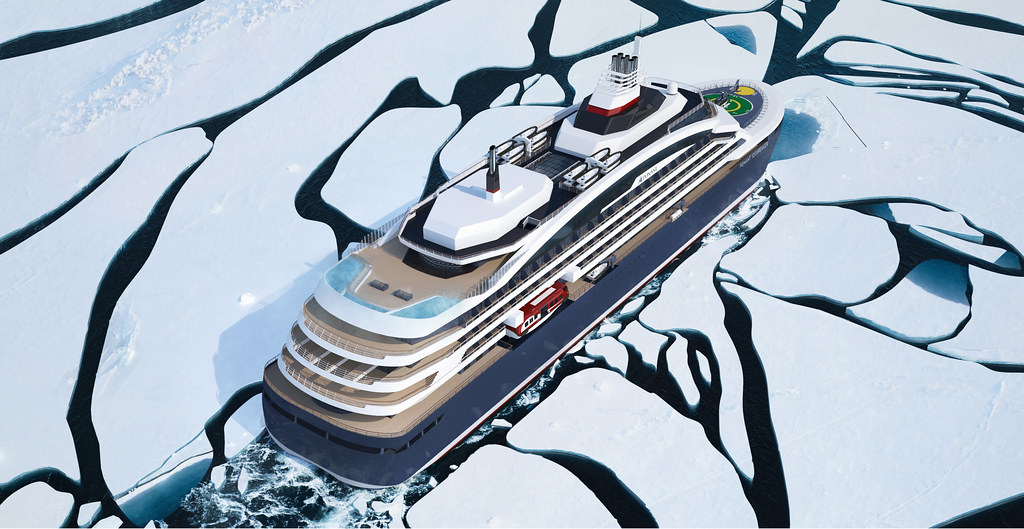#expeditioncruising .
With so many new and hi-tech expedition vessels coming online in the next few years, there is naturally a lot of hype around each one.
Revolutionary propulsion systems, radical hull designs and ultra clean and green energy and waste systems are all touted as the next greatest innovation since sliced bread.
So let’s fact check a few of these claims and the one catching my attention right now is the first passenger-specific icebreaker ever ordered, the 150m 30,000GT Ponant icebreaker. The hull is being built right now at Vard Tulcea in Romania.
Hybrid Propulsion
We all know of the hybrid cars now driving around from manufacturers like Lexus and Toyota. These cars use a combination of conventional petrol engine drive and switchable Lithium Ion electric drive either alone or in combination. Petrol engines can be smaller and more economical because they are supplemented by electric power from batteries charged using surplus kinetic energy like when the car is coasting or under brakes.
The principle used aboard hybrid ships is not a great deal different. There are generators, huge battery banks, electrically-driven propellers, Liquid Natural Gas (LNG) tanks and conventional diesel engines as well.
Norwegian line, Hurtigruten, will beat Ponant to the punch by launching the first-ever hybrid powered cruise ships. But while these will be regular Polar Class (PC) 6 vessels, Ponant’s icebreaker will be to PC2, PC1 being the strongest.
Different ship designs use hybrid technology in slightly different ways, but for the sake of this example, the propulsion on Ponant is purely electric with propellers like massive underwater fans attached to Azimuth Pods (or ‘Azipods’) which contain the huge electric motors and can swivel around through 360 degrees. Other expedition ships like Scenic's much-vaunted Eclipse (also PC6) will also use Azipods, but not with a hybrid propulsions systems.
The diesel engines inside the hull are necessary to drive the generators to create the electric power for the propellers, and much like a dual-fuel car which can drive by either conventional gasoline or Liquid Petroleum Gas (LPG), these massive diesel engines can run on either light marine diesel (MDO) or LNG.
So, is this hybrid propulsion all the Ponant spin doctors make it out to be? Quite possibly. It will depend on which is the primary fuel source (MDO or LNG) and for what duration either fuel is used. Either way, it is an enormous technological leap from the massive former-Soviet nuclear-powered icebreakers Yamal and 50 Years of Victory currently taking guests to the North Pole.
With so many new and hi-tech expedition vessels coming online in the next few years, there is naturally a lot of hype around each one.
Revolutionary propulsion systems, radical hull designs and ultra clean and green energy and waste systems are all touted as the next greatest innovation since sliced bread.
So let’s fact check a few of these claims and the one catching my attention right now is the first passenger-specific icebreaker ever ordered, the 150m 30,000GT Ponant icebreaker. The hull is being built right now at Vard Tulcea in Romania.
Hybrid Propulsion
 |
| Click to enlarge. (source: Ponant) |
We all know of the hybrid cars now driving around from manufacturers like Lexus and Toyota. These cars use a combination of conventional petrol engine drive and switchable Lithium Ion electric drive either alone or in combination. Petrol engines can be smaller and more economical because they are supplemented by electric power from batteries charged using surplus kinetic energy like when the car is coasting or under brakes.
The principle used aboard hybrid ships is not a great deal different. There are generators, huge battery banks, electrically-driven propellers, Liquid Natural Gas (LNG) tanks and conventional diesel engines as well.
Norwegian line, Hurtigruten, will beat Ponant to the punch by launching the first-ever hybrid powered cruise ships. But while these will be regular Polar Class (PC) 6 vessels, Ponant’s icebreaker will be to PC2, PC1 being the strongest.
Different ship designs use hybrid technology in slightly different ways, but for the sake of this example, the propulsion on Ponant is purely electric with propellers like massive underwater fans attached to Azimuth Pods (or ‘Azipods’) which contain the huge electric motors and can swivel around through 360 degrees. Other expedition ships like Scenic's much-vaunted Eclipse (also PC6) will also use Azipods, but not with a hybrid propulsions systems.
 |
| ABB Azipod like this rotates through 360 degrees and contains the electric motor for driving the fixed-pitch propellers. |
The diesel engines inside the hull are necessary to drive the generators to create the electric power for the propellers, and much like a dual-fuel car which can drive by either conventional gasoline or Liquid Petroleum Gas (LPG), these massive diesel engines can run on either light marine diesel (MDO) or LNG.
 |
| For the technically minded, these powerplants are of the Wärtsilä 31 DF type, recognised by Guinness World Records as the world's most efficient 4-stroke diesel engine. It is not disclosed yet which configuration is used in Ponant, as the twin-turbocharged W31 can be ordered in anything from 8 to 20 cylinder. V8 configuration pictured. (source) |
So, is this hybrid propulsion all the Ponant spin doctors make it out to be? Quite possibly. It will depend on which is the primary fuel source (MDO or LNG) and for what duration either fuel is used. Either way, it is an enormous technological leap from the massive former-Soviet nuclear-powered icebreakers Yamal and 50 Years of Victory currently taking guests to the North Pole.


No comments:
Post a Comment